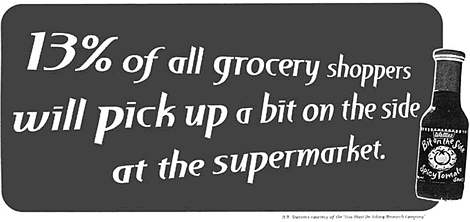FOOD
PRODUCT DEVELOPMENT
Mary Earle, Richard Earle and Allan Anderson |
| Loading
|
and post-launch evaluation |
|
||||
|
|
|
Part
3, Chapter 7
Case studies: product development in the food system 7.4.4 Stage 4: Product launch and post-launch evaluation The platform name was also strongly incorporated, and somewhat suggestively, in the publicity for the product. This was mainly by prominent billboards in the largest New Zealand (Auckland) market, just prior to and during the actual launch. It used a clever stratagem suggesting all manner of eager candidates for a 'Bit on the Side'; initially without revealing that a sauce was involved at all, and then completing the billboard by adding a picture of the labelled bottle, as illustrated in Fig.
7.3.
 Fig. 7.3 'Bit on the Side' sauce. The promotion certainly aroused curiosity and drew attention. The implication was that the competing sauces were everyday. These new Heinz Wattie's products were for 'experiential' eating as illustrated in Box 7.4, which it was hoped would carry buying forward into repeats, and towards habits.
There was also some limited TV advertising, featuring on brief cookery clips but at a very prime time spot. It was all well targeted. Sales of the new products rose rapidly, within three months, to brand leader, and the products have held a prime position on the New Zealand market since that time. Obviously a gap in the market was correctly identified, and filled, by satisfying products. A subsequent development was the withdrawal of two of the sauces. These two were closest to the volume-market, and to Heinz Wattie's previously existing sauces which so many customers had found to be adequately satisfying. Perhaps there was not enough differentiation from these still very popular, and cheaper, products. To add to the offering and coverage however, more new flavours were added to the platform, giving the range indicated in Table 7.6. Table 7.6 Heinz Wattie’s 'Bit on the Side' sauce range
After two years' success in New Zealand, 'Bit on the Side' sauce, with four products in the range, was introduced to the Australian market. After trials, the recipes had been modified and the flavours adapted to meet different consumer expectations. There was some both qualitative and quantitative consumer research. But the situation was rather different from that in New Zealand. There was a more advanced variety sauce market, better developed. There was TV promotion at the launch. But the market impact was substantially less than that in New Zealand. Analysis attributed this to the proliferation of sauces available in Australia and the segmentation of the market, to the campaign not building adequate initial awareness, and to the range offered being not large enough on the shelves there to impact sufficiently. Also it did not have the local momentum of the Wattie's brand that had helped carry it forward in New Zealand. The launch and subsequent history showed less impact and yielded smaller market share. Overall the development has had success, both for itself and for indications of new avenues for further product lines. The impressively tight timetable, which was achieved by the product developers, is shown clearly in Table 7.5. Market share in New Zealand has been well retained, the line is established on the supermarket shelves, and occupies a new slot for Heinz Wattie's. There are intentions to carry the concepts and lines forward to the Japanese market.
|
|
 |